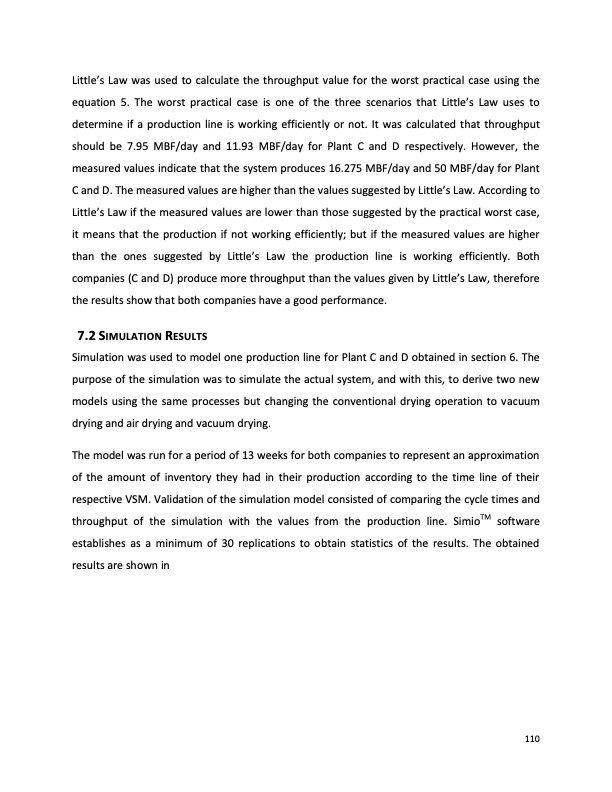
PDF Publication Title:
Text from PDF Page: 120
Little’s Law was used to calculate the throughput value for the worst practical case using the equation 5. The worst practical case is one of the three scenarios that Little’s Law uses to determine if a production line is working efficiently or not. It was calculated that throughput should be 7.95 MBF/day and 11.93 MBF/day for Plant C and D respectively. However, the measured values indicate that the system produces 16.275 MBF/day and 50 MBF/day for Plant C and D. The measured values are higher than the values suggested by Little’s Law. According to Little’s Law if the measured values are lower than those suggested by the practical worst case, it means that the production if not working efficiently; but if the measured values are higher than the ones suggested by Little’s Law the production line is working efficiently. Both companies (C and D) produce more throughput than the values given by Little’s Law, therefore the results show that both companies have a good performance. 7.2 SIMULATION RESULTS Simulation was used to model one production line for Plant C and D obtained in section 6. The purpose of the simulation was to simulate the actual system, and with this, to derive two new models using the same processes but changing the conventional drying operation to vacuum drying and air drying and vacuum drying. The model was run for a period of 13 weeks for both companies to represent an approximation of the amount of inventory they had in their production according to the time line of their respective VSM. Validation of the simulation model consisted of comparing the cycle times and throughput of the simulation with the values from the production line. SimioTM software establishes as a minimum of 30 replications to obtain statistics of the results. The obtained results are shown in 110PDF Image | Impact of Vacuum-Drying on Efficiency of Hardwood Products

PDF Search Title:
Impact of Vacuum-Drying on Efficiency of Hardwood ProductsOriginal File Name Searched:
Brenes_Angulo_OM_T_2014.pdfDIY PDF Search: Google It | Yahoo | Bing
5,000 BF Shipping Container Lumber Dry Kiln For Quality Lumber The 5,000 BF container kiln consists of one 40 foot high-cube aluminum shipping container... More Info
Shipping Container Lumber Dry Kilns by Global Energy Global Energy designed and developed the container kiln back in 1991. The purpose is to give access to portable sawmill owners, furniture makers, and small business the value added profit of dry kiln lumber and quality hardwoods... More Info
Vacuum Kiln Conversion Kit for Lumber and Wood Dry Kilns Convert your existing conventional dry kiln into a fast drying vacuum kiln. Similar to vacuum bagging in the boat building and aircraft industry, we have come up with a proprietary process which allows you to build a very simple vacuum kiln at a fraction of the price, and without the intensive conventional metal chamber structure... More Info
Vacuum Pump Cart System for Bagging Clamping Wood Drying and more Vacuum Cart with 2HP Pump and Dual Pistons with multiple multiplex vacuum ports and liquid reservoir... More Info
Vacuum Bagging Basics Vacuum bagging is a method of clamping, which has traditionally been used in the composites industry, but can also be used for vacuum drying materials, including wood products... More Info
| CONTACT TEL: 608-238-6001 Email: greg@globalmicroturbine.com | RSS | AMP |